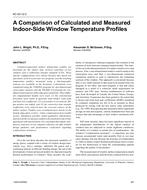Description
Computer-generated surface temperature profiles are presented for the indoor side, vertical centerline of two windows and a calibration transfer standard (CTS). These specific configurations were chosen because they match test specimens used in a previous test program, and the resulting temperature profiles, measured using a thermographic camera, are available in the literature. Calculations were completed using the VISION4 program for one-dimensional center-glass analysis and the FRAME 4.0 program for two-dimensional analysis of the edge-glass and frame. Three different computational models were used: (1) the conventional procedure used widely to generate total-window solar gain and heat loss coefficients, (2) a procedure to account for fill-gas motion was added, and (3) the convective heat transfer coefficients were reduced near the recessed corners of the indoor surface. Profiles were scrutinized most closely at the bottom edge-glass section—where condensation most readily occurs. Simulation provides useful qualitative information, and each of the two features added to the model provides better agreement with measurement. It is concluded that simple, inexpensive, and easy-to-use computer software can offer reliable design guidance and performance verification regarding condensation resistance.
Units: Dual
Citation: Symposium, ASHRAE Transactions, vol. 109, pt. 2, Kansas City, 2003
Product Details
- Published:
- 2003
- Number of Pages:
- 14
- File Size:
- 1 file , 4.8 MB
- Product Code(s):
- D-20891




